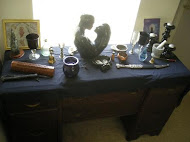Image from Suratt House Museum: A Victorian Herb Garden
PLEASE NOTE: Rue may be poisonous if ingested, and it is best administered by a practitioner familiar in this product. It should not EVER be taken by pregnant women because of it may affect uterine contractions and blood flow. It should also be avoided by children and nursing women, and by those who are allergic to the plant. May cause photo toxicity in some individuals, (some people are highly sensitive to the plant's oils and can develop a severe rash when they are exposed to it and then the sun.) An excess of rue causes vomiting and can interfere with the liver's workAlso Called: Herb-of-Grace, Herb of Grace, Herbygrass, Garden Rue, Mother of Herbs, Rewe, and Goat's Rue. The name Ruta is from the Greek reuo (to set free), because this herb is so efficacious in various diseases. Rue, a hardy, evergreen, somewhat shrubby plant, is a native of Southern Europe, blossoming from June to September. Introduced by the Romans, it is not found in a wild state except rarely on the hills of Lancashire and Yorkshire.
Throughout history, Rue has been used for everything from flavoring cheese to driving out evil spirits. Yet, no one use seemed to really catch on. Shakespeare called Rue the ' herb of grace' and a short time later it became associated with repentance. Sprigs of rue were used to sprinkle holy water in early Christian rituals. The species name graveolens means strong smelling. It was much used by the Ancients ; Hippocrates specially commended it, and it constituted a chief ingredient of the famous antidote to poison used by Mithridates. The Greeks re-garded it as an anti-magical herb, because it served to remedy the nervous indi-gestion they suffered when eating before strangers, which they attributed to witchcraft. During the Middle Ages, rue was hung in doorways and windows to keep evil spirits out. It was thought to protect against plague, and since people also rubbed their floors with fresh rue to keep out fleas, it probably did. It is good for purifying objects made of iron, Mars' metal, before consecrating them. Rue was sometimes called witchbane because people carried bunches to keep off witches (who must have been thick as mosquitoes in those days), and the ex-pression "rue the day" is said to come from the practice of throwing rue at an enemy while cursing him. In the 18th and 19th centuries, Italians made amulets called cimaruta from tin or silver made to resemble the tops of rue. The tip of each branch was decorated with a symbol, usually concerned with fertility : phalli, horns, solar disks, crescent moons, fish, keys, even the Sacred Heart of Jesus (how'd that get in there?). A cimaruta was meant to protect the wearer from the evil eye. Nowadays, rue is thought to be ritually helpful in developing second sight, probably because it has a long history as a medicinal herb for strained eyes (Italian Renaissance painters regularly ate rue and cress sandwiches to sharpen their eyesight), and for bringing blessings and protection to one's home. The legend of rue lives on in playing cards, where the symbol for the suit of clubs is said to be modeled on a leaf of rue.
Rue has many medicinal uses, being strongly stimulating and antispasmodic - often employed, in form of a warm infusion, as an emmenagogue. In excessive doses, it is an acro narcotic poison, (a substance that acts on the brain, spinal marrow, or both, and simultaneously irritating the parts of the body to which it is applied) and on account of its emetic (causes emesis, that makes you want to vomit. For example, ipecac is an emetic) tendencies should not be administered immediately after eating. It forms a useful medicine in hysterical affections, in coughs, croupy affections, colic and flatulence, being a mild stomachic.The oil may be given on sugar, or in hot water. If bruised and applied, the leaves will ease the severe pain of sciatica. The expressed juice, in small quantities, was a noted remedy for ner-vous nightmare, and the fresh leaves applied to the temples are said to relieve headache. Compresses saturated with a strong decoction of the plant, when ap-plied to the chest, have been used beneficially for chronic bronchitis. If a leaf or two be chewed, a refreshing aromatic flavor will pervade the mouth and any ner-vous headache, giddiness, hysterical spasm, or palpitation will be quickly re-lieved. Rue has also been used as a specific against epilepsy and vertigo, and for the former malady, at one time, some of this herb would be suspended round the neck of the sufferer. Rue is said to be of such effect for the preservation of sight that the painters of Pliny's time used to devour a great quantity of it, and the herb is still eaten by the Italians in their salads. It was said to make the sight both sharp and clear, especially when the vision had become dim through overexertion of the eyes. Rue has been regarded from the earliest times as successful in warding off contagion and preventing the attacks of fleas and other noxious insects - rue-water sprinkled in the house 'kills all the fleas,' says an old book. It was the custom for judges sitting at assizes to have sprigs of Rue placed on the bench of the dock against the pestilential infection brought into court from gaol by the prisoner, and the bouquet still presented in some districts to judges at the assizes was originally a bunch of aromatic herbs, given to him for the purpose of warding off gaol-fever. The juice was used against earache.
Many spiritual paths have recognized the potency of rue: It apparently got the name Herb of Grace because early Christians used it as a tool for asperging during exorcisms and before performing mass, and this herb is the only one that the Prophet Mohammed blessed. It was grown around Roman temples to Mars and is considered sacred to him as well as to Diana and Aradia. Magical uses include healing, health, mental powers, freedom and protection against the evil eye. In the Middle Ages (and later), it was considered - in many parts of Europe - a power-ful defense against witches, and was used in many spells. It was also thought to bestow second sight. Use as an asperger to cast salt water for purification of the circle or removing negativity from the home. Hanging the dried herb indoors will help yourself see and understand your mistakes. Rue can be burned to banish negativity or bad habits, and is added to incenses and poppets to prevent illness or speed recovery. Adding to baths is said to break hexes and curses that may have been placed against you. Rue should be worn to bring healing and ward off problems with health. Smelling the fresh plant is said to bring clear thinking in love and improve mental acumen. Exorcism incense and mixtures are made with it and when grown in the garden, rue protects it. It is used in home blessings and magic to bring protection and good fortune to the home and family. Rue is one of the ingredients used in the Vinegar of Four Thieves.
The Magickal Cat
Botanical.com: A Modern Herbal
Disclaimer: No one involved in this blog or its contents may be held responsible for any adverse reactions arising from following any of the instructions/recipes on this list. It is the reader's personal responsibility to exercise all precautions and use his or her own discretion if following any instructions or advice from this blog.
















2 comments:
Interesting information! I have read a little about rue but learned a lot from this post. Thanks!
Thanks for coming by! It's nice to know the information is helpful :)
bb
dawtch
Post a Comment